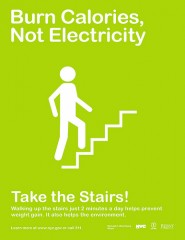Recently, when I was returning home after a long day at school, I found myself startled after observing some rather young men, roughly in their twenties, riding the elevator to the second and third floors. What shocked me specifically was the mere fact that they preferred to wait and then board an elevator rather than travel such a short distance up the stairs to their destinations. Perhaps I felt this way due to the fact that it is frequently said that taking the stairs is better for the environment than taking the elevator. The nuance attached to my previous reaction is that most times, this doesn’t really explain in detail how taking the stairs can affect our lives. In fact, the first thought which may come to mind is that using the stairs rather than the elevator is better for one’s health and can reduce the electricity consumption within the building. Are both of these facts valid? Not really. In actuality, if we look at the energy use in elevators, they do not consume as much electricity as we may have assumed.
For instance, calculations have shown that using an elevator, when measuring the amount of energy used from floor to floor, does not utilize vast amounts energy. In fact, only 2.5Wh of electricity is used per floor, which is the energy equivalent to recharging a cellphone battery.
The way some buildings are designed has proven that taking the stairs can be beneficial for our health and also in how we interact with others. A great example is the skip-stop elevator used at the Cooper Union building by Morphosis. This one only stops at the first, third and eight floors, forcing the students to take the main stairs to the floor of their desire. This “interior promenade” provides a good communication and ambiance between them and also promotes a healthy lifestyle by taking the stairs. [1]
Additionally, although we might not save a large amount of energy by taking the stairs instead of the elevator, a good exercise is always better for our bodies in the end. As a matter of fact, a 150lb person climbing stairs for a minute will burn 10 calories, which is a lot if you think about the amount of calories they can burn per year. This 150 lb. person who walks up three flights of stairs six times a day can burn 32,850 calories in a year.[2]

To summarize this, even though the energy consumed by elevators is really minute, it is still important to us to reduce its use especially when we are going a few floors up. So the next time you are in a building and have to go to the nearest floors, feel free to take the stairs and think about the benefits it can bring your way!

